Slinzega is a type of air-dried meat produced in Valtellina and Valchiavenna valleys, in the Italian Alps. It is made in a similar manner to bresaola, with smaller pieces of meat, which therefore bear a stronger taste. According to some sources, it originally used horse meat rather than beef. Nevertheless, today virtually any type of meat is suitable for its production; the most common being beef, deer and pork.
Aesthetically it looks quite similar to bresaola, but it is produced in much smaller sizes (300–800 g) [1] and has a much stronger flavor due to the aromatization with salt, cinnamon, cloves, garlic, bay leaf and pepper.
The charcuterie lasts about a month. [2]
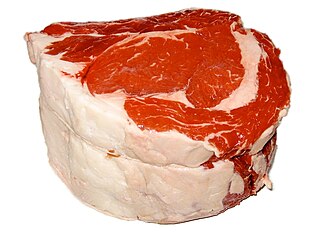
Beef is the culinary name for meat from cattle. Beef can be prepared in various ways; cuts are often used for steak, which can be cooked to varying degrees of doneness, while trimmings are often ground or minced, as found in most hamburgers. Beef contains protein, iron, and vitamin B12. Along with other kinds of red meat, high consumption is associated with an increased risk of colorectal cancer and coronary heart disease, especially when processed. Beef has a high environmental impact, being a primary driver of deforestation with the highest greenhouse gas emissions of any agricultural product.

Lombardy is an administrative region of Italy that covers 23,844 km2 (9,206 sq mi); it is located in northern Italy and has a population of about 10 million people, constituting more than one-sixth of Italy's population. Lombardy is located between the Alps mountain range and tributaries of the river Po, and includes Milan, its capital, the largest metropolitan area in the country, and among the largest in the EU.

Biltong is a form of dried, cured meat which originated in Southern African countries. Various types of meat are used to produce it, ranging from beef to game meats such as ostrich or kudu. The cut may also vary being either fillets of meat cut into strips following the grain of the muscle, or flat pieces sliced across the grain. It is related to beef jerky; both are spiced, dried meats; however the typical ingredients, taste, and production processes may differ.

Lunch meats—also known as cold cuts, luncheon meats, cooked meats, sliced meats, cold meats, sandwich meats, delicatessens, and deli meats—are precooked or cured meats that are sliced and served cold or hot. They are typically served in sandwiches or on a tray. They can be purchased pre-sliced, usually in vacuum packs, or they can be sliced to order.
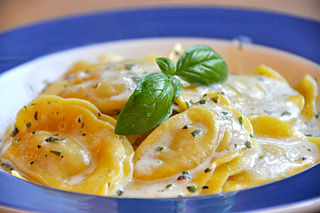
Ravioli are a type of stuffed pasta comprising a filling enveloped in thin pasta dough. Usually served in broth or with a sauce, they originated as a traditional food in Italian cuisine. Ravioli are commonly square, though other forms are also used, including circular and semi-circular (mezzelune).

Bresaola is air-dried, salted beef that has been aged two or three months until it becomes hard and turns a dark red, almost purple colour. It is made from top (inside) round, and it is lean and tender, with a sweet, musty smell. It originated in Valtellina, a valley in the Alps of northern Italy's Lombardy region.

Capocollo or coppa is a traditional Italian and French (Corsica) pork cold cut (salume) made from the dry-cured muscle running from the neck to the fourth or fifth rib of the pork shoulder or neck. It is a whole-muscle salume, dry cured, and typically sliced very thin. It is similar to the more widely known cured ham or prosciutto, because they are both pork-derived cold cuts used in similar dishes. It is not brined as ham typically is.

Dried meat is a feature of many cuisines around the world. Examples include:
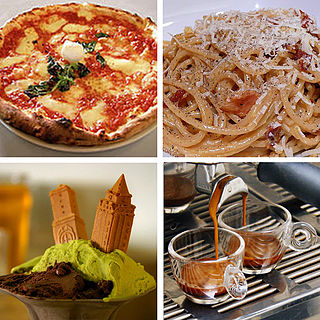
Italian cuisine is a Mediterranean cuisine consisting of the ingredients, recipes and cooking techniques developed in Italy since Roman times and later spread around the world together with waves of Italian diaspora. Some of these foods were imported from other cultures. Significant changes occurred with the colonization of the Americas and the introduction of potatoes, tomatoes, capsicums, maize and sugar beet—the latter introduced in quantity in the 18th century. It is one of the best-known and most appreciated gastronomies worldwide.

In Spanish, cecina is meat that has been salted and dried by means of air, sun or smoke. The word comes from the Latin siccus (dry), via Vulgar Latin (caro) *siccīna, "dry (meat)".

Bündnerfleisch, also known as Bindenfleisch, Grisons Meat or Viande des Grisons, is an air-dried meat that is produced in the canton of Graubünden, Switzerland.

A round steak is a beef steak from the "round", the rear leg of the cow. The round is divided into cuts including the eye (of) round, bottom round, and top round, with or without the "round" bone (femur), and may include the knuckle, depending on how the round is separated from the loin. This is a lean cut and it is moderately tough. Lack of fat and marbling makes round dry out when cooked with dry-heat cooking methods like roasting or grilling. Round steak is commonly prepared with slow moist-heat methods including braising, to tenderize the meat and maintain moisture. The cut is often sliced thin, then dried or smoked at low temperature to make jerky.
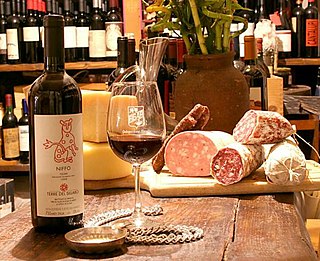
Salumi are Italian meat products typical of an antipasto, predominantly made from pork and cured. Salumi also include bresaola, which is made from beef, and some cooked products, such as mortadella and prosciutto.

Italian meal structure is typical of the European Mediterranean region and differs from Northern, Central, and Eastern European meal structure, though it still often consists of breakfast (colazione), lunch (pranzo), and supper (cena). However, much less emphasis is placed on breakfast, and breakfast itself is often skipped or involves lighter meal portions than are seen in non-Mediterranean Western countries. Late-morning and mid-afternoon snacks, called merenda, are also often included in this meal structure.

Suho meso is a smoked beef preparation eaten in Bosnian, Serbian, Croatian and Montenegrin cuisine. The meat is cured in a coarse salt for multiple days before being hung to dry over a fire for multiple days or weeks, depending on the size of meat. This process is traditionally done in the winter to avoid the meat from spoiling. It is similar to Pastirma, except there is no specific spice blend Çemen spread around the meat.
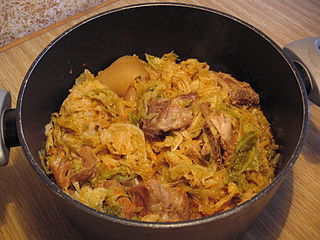
Lombard cuisine is the style of cooking in the Northern Italian region of Lombardy. The historical events of its provinces and of the diversity of its territories resulted in a varied culinary tradition. First courses in Lombard cuisine range from risottos to soups and stuffed pasta, and a large choice of second course meat or fish dishes, due to the many lakes and rivers of Lombardy.

A salumeria is a food producer and retail store that produces salumi and other food products. Some only sell foods, while not producing on-site, and some have a restaurant with sit-down service. The salumeria originated in Italy, and dates to the Middle Ages.

Bisciola is an artisanal Italian sweet leavened bread originating from the Valtellina valley of Lombardy, Italy. It is typically prepared for Christmas during which time it is an essential component of Christmas festivities.